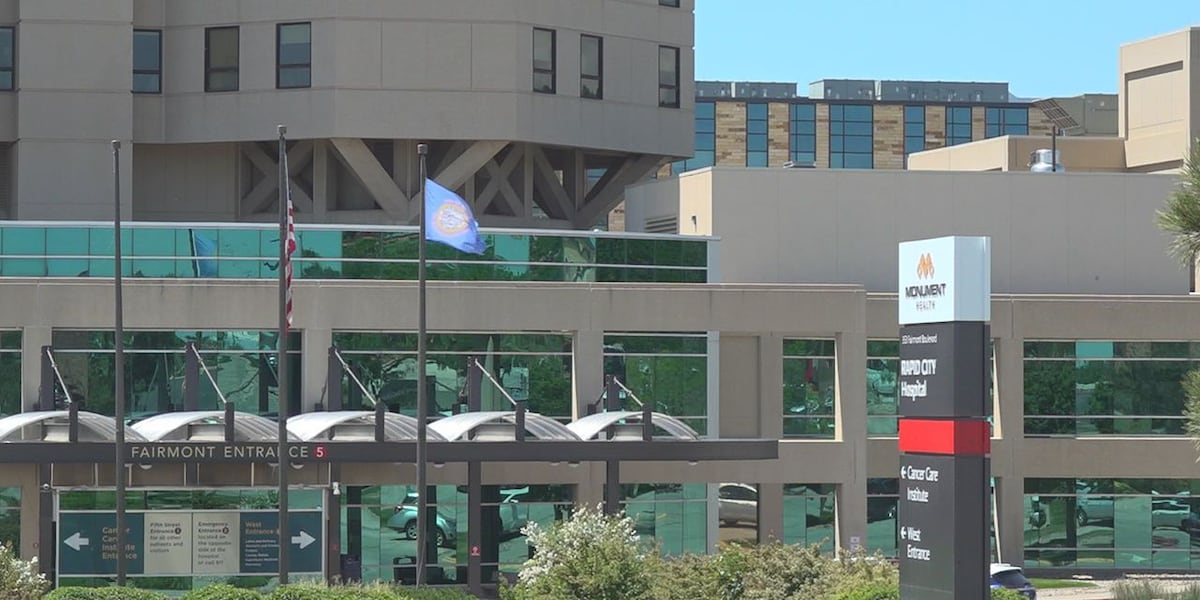South Dakota
SF East sweeps Pierre in Legion doubleheader at Harmodon Park
/cloudfront-us-east-1.images.arcpublishing.com/gray/7ODIJNOJ4FHXHCRCFZQ7DAUGOU.jpg)
SIOUX FALLS, S.D. (Dakota News Now) -SF East kept a perfect record in tact early in the South Dakota Legion schedule by sweeping a doubleheader from Pierre 11-2 and 5-4, It was a busy night in Legion Baseball. See the scores in the DNN scoreboard as Mitchell swept two from Huron, Brandon Valley split with SF West, Yankton took two from Watertown and Brookings and RC Post 22 split their 2 games.
Copyright 2023 KSFY. All rights reserved.

South Dakota
Sexually transmitted parasite found in South Dakota cattle herd
A South Dakota cattle herd has tested positive for a venereal disease.
The South Dakota Animal Industry Board announced in a Wednesday press release the disease, bovine trichomoniasis, was found in bull from a beef cattle herd in Bennett County.
Otherwise known as “trich,” the disease is caused by trichomonas foetus, a parasite that is transmitted between cows and bulls during breeding.
According to the Animal Plant and Health Inspection Service, trichomoniasis is endemic in the U.S. and is a particular problem in midwestern and western regions of the country.
Beth Thompson, state veterinarian and AIB head, said it’s hard to determine the commonality of the disease, but she clarified this is the first time the disease has been found in the state since 2019, when two positive cases were identified.
The disease can be particularly devastating for cattle herds, as the parasite can induce early term abortions and infertility in breeding cows.
“It’s economically important, if you don’t catch it early … Not only are you going to cause issues in the cows themselves, but it can reduce the calf crop significantly,” Thompson told the Argus Leader Wednesday.
Thompson added it is too early to say how trich entered into the cattle herd.
“The Animal Industry Board is working with the herd owner and their veterinarian to develop a management plan to contain the disease,” the board stated in the release. “Neighboring herd owners with potential contact animals will be informed of the risk to their animals as the investigation continues.”
AIB advises producers to only purchase and use virgin bulls for breeding. South Dakota Administrative Rule requires non-virgin bulls to test negative for the disease prior to being sold, loaned or leased in the state for breeding purposes. All non-virgin bulls entering the state must also test negative for trich. The state bans the importing, loaning and leasing of open cows in South Dakota.
Bulls may also be tested two weeks after breeding for early detection of potential problems, the release stated. Timely pregnancy testing of females following the breeding season and prompt removal of open cows to be sold for feeding and slaughter will decrease the risk of disease spread.
Cattle producers with concerns about trichomoniasis should contact their herd veterinarian or the AIB at605-773-3321.
South Dakota
South Dakota youth participate in rangeland and soils education

WATERTOWN, S.D. — With a history of giving students hands-on experiences on rangeland and soils education, the 40th annual rangelands and 19th annual soils days for youth was held June 12-13 in Watertown, South Dakota.
SDSU Extension, Codington Conservation District and the USDA Natural Resources Conservation Service of South Dakota cohosted the event, which provided youth ages 8 to 18 with hands-on education in rangeland and soils. To participate, youth were given the options to create educational displays on range-related topics, give speeches and compete in rangeland and soil judging.
Krista Ehlert, assistant professor and range specialist for SDSU Extension, believes that providing these kinds of educational experiences is an investment for the future.
Contributed / SDSU Extension
“I actually had one of the producers that I work with tell me, ‘If you want to invest in the future, invest in a youth; invest in a child,’ and I think that’s really true,” she said. “That’s something that we achieve through rangeland and soils days, is investing in our future.”
There were around 110 students participating this year, up from around 75 the previous year. Ehlert said that the event changes locations every two years to accommodate for travel between both East River and West River students.

Contributed
“We increased our student numbers this year, so we’re really happy about that and we’ll see what we get next year,” Ehlert said. “We hope that we put it on in such a way that people don’t mind traveling, and feel like it’s worth it, no matter where it is.”
Students spend time in the field learning about rangelands and soils to prepare for the contest on the first day and then student displays and speeches are presented in the evening. The rangeland and soil judging contests start the morning of the second day.
Rangeland has four age divisions including new rangers for ages 8 to 10, wranglers for ages 8 to 11, scouts for ages 14 to18 and go-getters which are also for ages 14 to18. Each division judges habitat suitability for beef cattle and prairie grouse, in addition to learning plant identification and morphology.
Youth ages 14 to 18 are also given the option to compete in the land and homesite contest which provides an opportunity to learn more in-depth about soil texture and type, factors that limit soil health, and how to determine land capability with management recommendations. The homesite evaluation contest teaches how to determine the suitability of sites for building foundations, lawns and landscaping, septic systems and sewage lagoons.

Contributed
Lance Howe, soil scientist for the Natural Resource Conservation Service based out of Redfield, South Dakota, coordinates the land and homesite contest and has a long history of helping with the rangeland and soils days, having assisted with the event since 1999.
Howe feels rangelands and soils days help students learn about different career paths and the environment.
“This is all about giving students an opportunity to see career opportunities and what’s involved with them,” he said. “It’s really about teaching the students why the environment is important and resources of the soils and range of plants, but it’s also about them learning the different career opportunities out there to help our positions down the road.”
Landon Wolter, a rangeland management specialist with the Natural Resource Conservation Service Soil and Plant Division based out of the South Dakota Soil Survey Office in Redfield, South Dakota, got a taste for his future career by attending the rangeland and soils days each year while he was a student.

Contributed
Growing up in Wessington Springs, South Dakota, Wolter was heavily involved in 4-H and FFA. After attending his first rangeland and soils days as a freshman in high school, Wolter earned spots on the state teams and saw success competing at the national level. He then went on to attend South Dakota State University, earning a degree in ecology and environmental science with a specialization in rangeland management.
Wolter is now continuing his involvement with the rangeland and soils days by setting up sites for both contests and practices this year and credits opportunities like this for providing with him practical skills needed for his future.
“You’re getting kids to think about managing those natural resources, thinking about what impacts we have on the system, how we can alter the system both negatively and positively and the impact of our management decisions,” he said. “I think that’s something that’s extremely relevant for students to see even if they’re not from an agricultural background, it has implications for them.”
Kennedy is a reporter for Agweek based out of South Dakota. She grew up on an organic crop farm where her family also raises cattle in eastern South Dakota. She graduated from South Dakota State University in 2023 with a major in agricultural communication and minor in agricultural business. She enjoys connecting with producers and agribusinesses across the region while reporting on all things agriculture.
South Dakota
American Red Cross helps with flood response in southern Minnesota, southeast South Dakota

FARGO, N.D. (Valley News Live) – As flooding continues across southern Minnesota and southeast South Dakota, volunteers with the American Red Cross Minnesota and Dakotas Region are lending a helping hand.
As of Tuesday evening, more than 120 people from the Minnesota and Dakotas Region branch of the Red Cross are helping communities impacted by the flood. More than 500 homes have been assessed while more than 1,2000 emergency relief supply kits have been given.
“That’s really what makes the Red Cross so special is we’ve got many people that care and are with people in some of their toughest times,” said Christopher Larson, a regional communications volunteer with the Red Cross.
If you’d like to help, you can volunteer, donate money, or donate blood. Those at the Red Cross say sometimes these disasters cancel blood drives and that can impact giving blood to those who need it down the road.
For more information and to help out, you can click here.
Copyright 2024 KVLY. All rights reserved.
-

 Politics1 week ago
Politics1 week agoBiden official says past social media posts don’t reflect ‘current views,’ vows to support admin ‘agenda’
-

 News1 week ago
News1 week agoWoman accused of trying to drown Muslim child in Texas in possible hate crime
-

 World1 week ago
World1 week agoIsrael accepts bilateral meeting with EU, but with conditions
-

 World1 week ago
World1 week agoNetanyahu says war will continue even if ceasefire deal agreed with Hamas
-

 Movie Reviews1 week ago
Movie Reviews1 week agoMovie Review: “Casablanca” – A Timeless Masterpiece –
-

 Politics1 week ago
Politics1 week agoSupreme Court to review Tennessee ban of puberty blockers, transgender surgery for minors
-

 News1 week ago
News1 week agoSupreme Court to decide whether states can restrict gender-affirming care for minors | CNN Politics
-
/cdn.vox-cdn.com/uploads/chorus_asset/file/25500699/DSCF7644.jpg)
/cdn.vox-cdn.com/uploads/chorus_asset/file/25500699/DSCF7644.jpg) Technology1 week ago
Technology1 week agoHow Apple is trying to make Final Cut Pro a “touch-first” video editing app



















